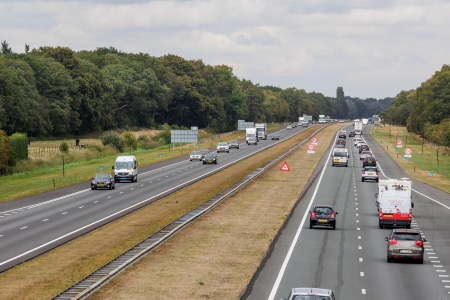A safe roadside is designed to prevent run-off-road crashes, or at least those with a serious outcome. A safe roadside allows vehicles that have drifted off the lane to be steered back into the lane in a controlled manner, to come to a safe stop on the roadside, or to be protected by a shielding structure designed to prevent serious injury. A safe roadside is 'forgiving'. In addition, road users should not be distracted by advertising or other objects on the roadside (see SWOV fact sheet Distraction in traffic.
Forgiving roadside
Firstly, a safely designed roadside has a sufficiently wide emergency lane or narrow paved shoulder, so that a run-off-road crash is prevented as far as possible. A narrow paved shoulder or hard strip is intended to allow drivers to return to the lane (if they are still in control of the vehicle, see the question Which types of run-off-road crashes can be distinguished?. An emergency lane is wider, and is also intended for use as a refuge in case of an emergency or breakdown.
Secondly, a safe roadside is designed such that drivers who have hit the roadside do not lose control of their vehicles. This is particularly relevant for run-off-road crashes in which the driver has maintained control of the vehicle (see the question Which types of run-off-road crashes can be distinguished?). A safe roadside therefore has the smallest possible difference in level between the carriageway (road surface) and the roadside. Ideally, there should also be a (unpaved) semi-hardened shoulder next to the carriageway: grass-concrete bricks, plastic mats or stone mixtures whose appearance differs markedly from the carriageway. A semi-hardened shoulder makes it easier to control the vehicle and increases the likelihood of the driver steering the vehicle back to the road or stopping it safely. At the very least, the entire roadside is load-bearing so that the wheels do not sink into it.
Third, but no less important, a safe roadside has a sufficiently wide clear zone and/or shielding structure to prevent crashes with a serious outcome. The safest design is a clear zone combined with a shielding structure at its end, at some greater distance along the road [8]. See Figure 3.

Clear zone
The obstacle-free zone or clear zone is the area along the road in which there should be no hazards or obstacles that could cause serious damage or injury in case of a crash [24]. Hazards include, for example, trees, gantries and ditches. Side slopes, for example, may be present within the clear zone, provided they are not too steep, as well as so-called 'crashworthy' road furniture.
The prescribed width of the clear zone depends on the speed limit or design speed of the road: 2.5 metres at 60km/h, 6 metres at 80km/h, 10 metres at 100km/h and 13 metres at 120km/h as the speed limit. For roads with a speed limit of 130km/h, the design speed is 120km/h.
Shielding structure
A roadside shielding structure, (cable)barrier or guardrail, has the following safety characteristics:
The shielding structure is flexible.
Flexible shielding structures imply that road users experience reduced forces to the body when crashing with the structure. The most flexible are cable barriers. Guard rails can also be reasonably flexible. Concrete barriers are in general the least flexible and therefore not forgiving [9] [20].
There are no obstacles or objects within the 'working width'.
The working width is the degree to which the shielding structure deflects transverse to the driving direction during a crash. If an obstacle or any other object is too close to the shielding structure, a crash may have a serious outcome.
The shielding structure is outside the emergency/recovery zone.
This way, there is room for vehicle breakdowns, and for drivers to safely steer back or stop their vehicles if necessary. A vehicle is also less likely to bounce back onto the carriageway. Finally, this provides space (to make way) for emergency services.
The shielding structure starts well ahead of the obstacle.
If, in the longitudinal direction, the shielding structure starts 'too late' (too near the object), a vehicle may overshoot the structure and still crash with the obstacle [15].
The starting points of the shielding structure are safely designed.
Starting points (called end points) should be fitted with a forgiving terminal or possibly crash cushion and - in the case of a terminal - can additionally be 'flared'. When flared, it is important that the shielding structure enters the roadside at the correct angle and length [15].
